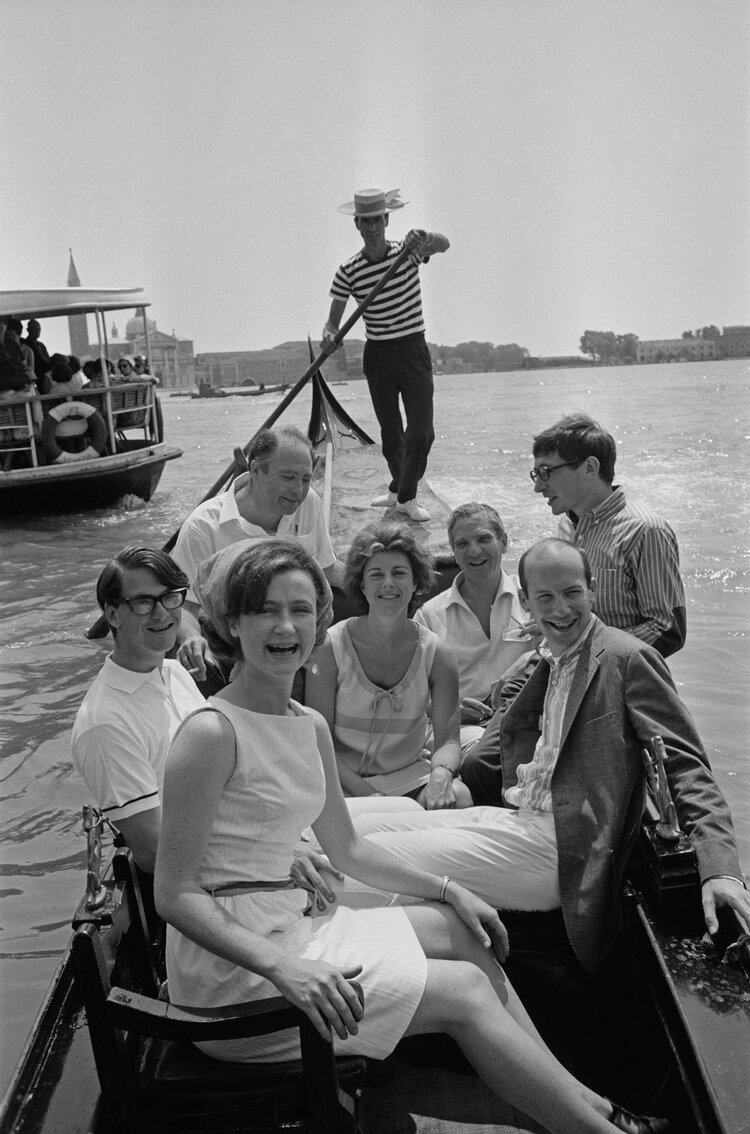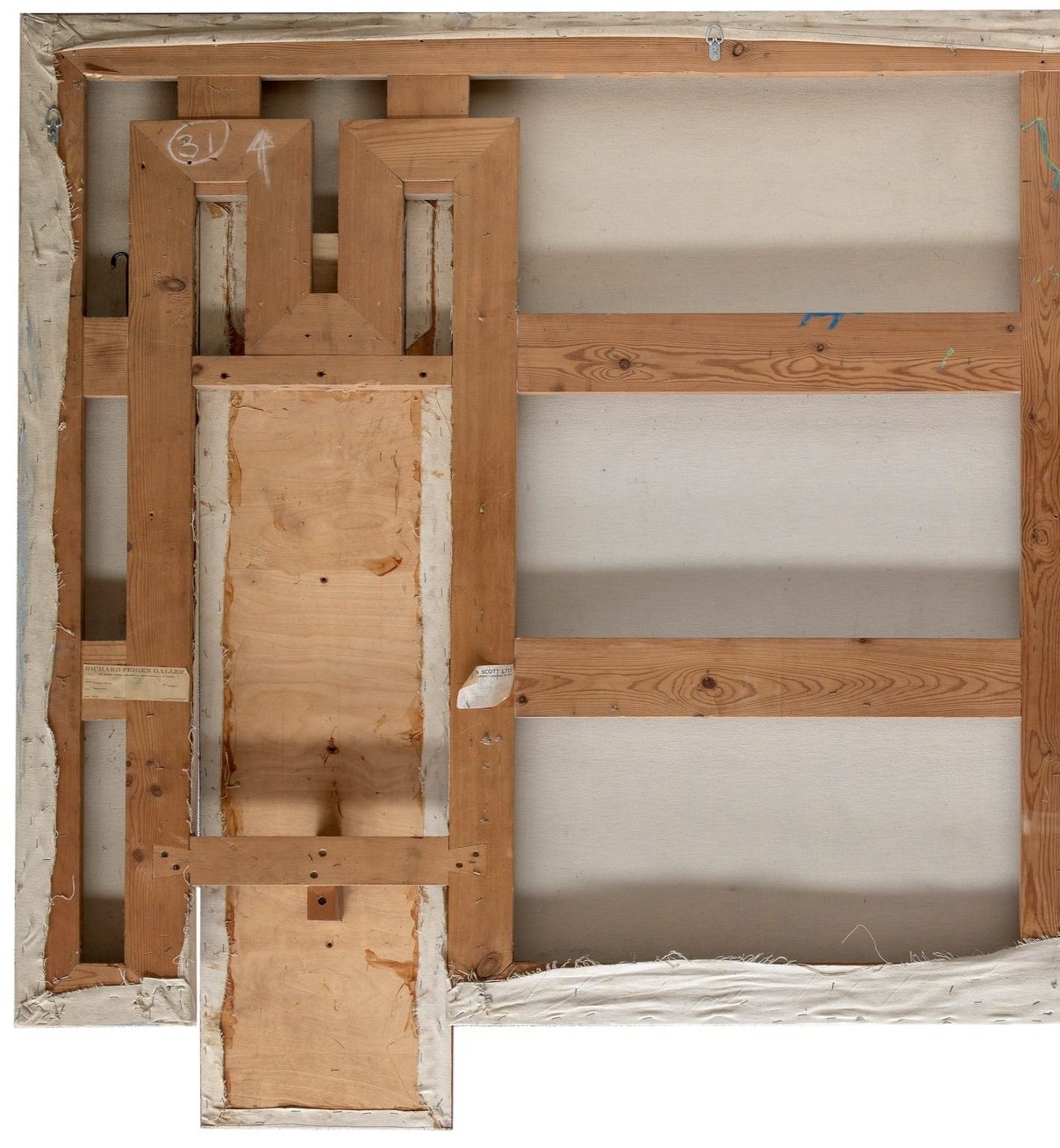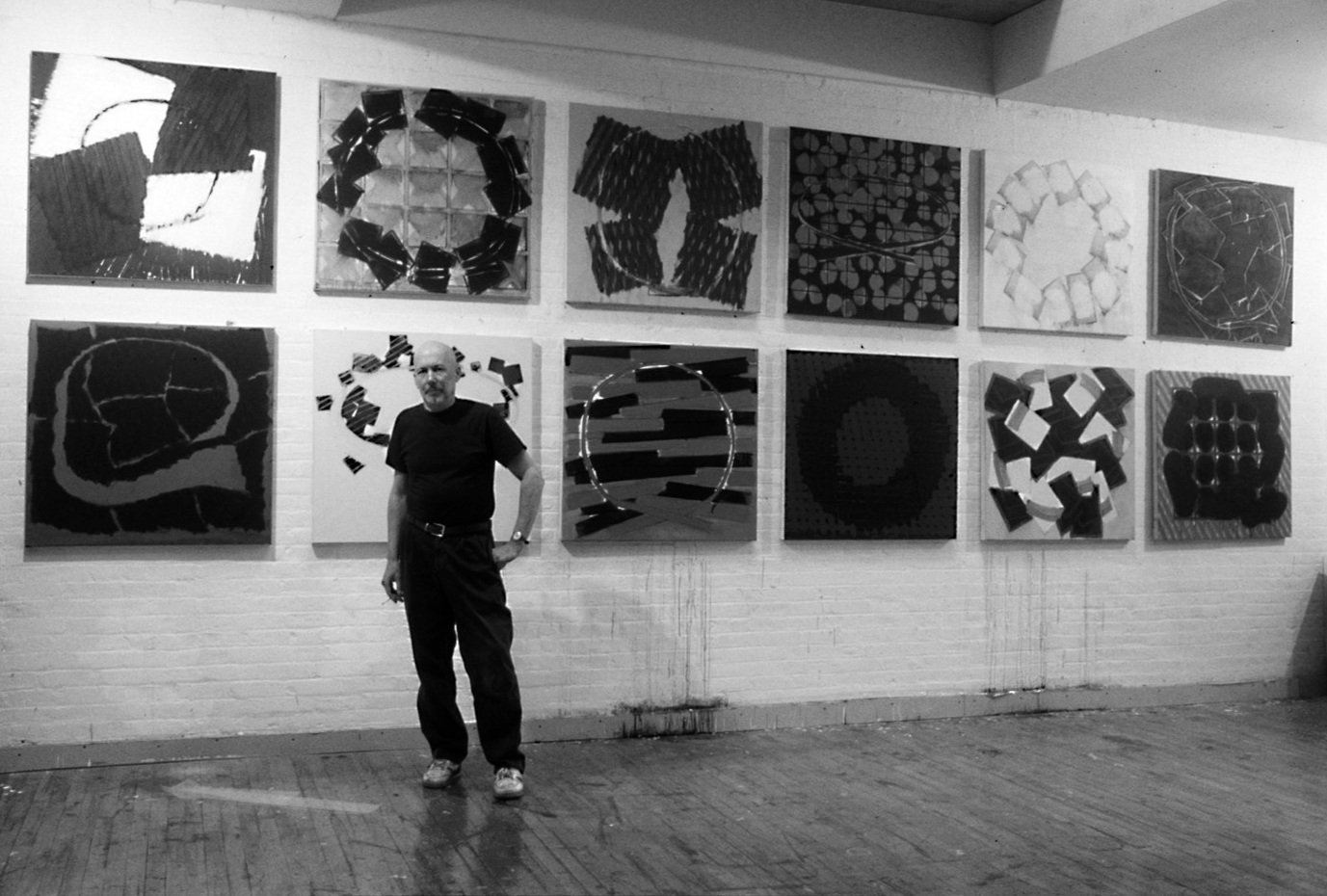
Richard Smith: 1970–1983
31 March – 12 May 2021
Online Presentation
Richard Smith (lower right) at the Venice Biennale in 1966, with (from left) Sheridan and Lindy Dufferin, Jules Olitski, Helen Frankenthaler, Anthony Caro and John Kasmin. © Photo: Reg Lancaster
Explore this online Presentation highlighting a group of works by pioneering British artist Richard Smith (1931-2016). The Presentation reflects Smith’s testing of the limits of painting through a number of distinct bodies of work; from the shaped canvases of the late 60s and 70s, through to the kite works, and the reversion back to flat canvas in the 80s.
In the late 50s, Smith travelled to America on the Harkness Fellowship and was inspired by his American colleagues and his time there. Yet his work took on a more restrained output, with less obvious emotional content. His imagery tended to be much more concrete, and always straddled a number of motifs; ‘Neither pop nor minimal, neither colour-field abstraction, nor literal three-dimensional object’1. He has always been Richard Smith – in between these parameters.
Richard Smith in front of Riverfall on the occasion of his Tate retrospective in 1975. Photograph: Rowland Scherman
He became known in the 60s and 70s for his odd-shaped, wall-hanging canvases, which drew heavily on high-end advertising of the time. They are Pop inasmuch they draw source from ephemera of the world, but Smith’s interest was more luxury and less demotic. And as such, the imagery which results is less pictorial than his Pop colleagues; more painterly.
Mandarin, 1970
acrylic on canvas
169 x 303 cm / 67 x 120 in
Further information on request
Mandarin, 1970, the largest painting in our Presentation, marries a few key elements of Smith’s output in the preceding decade. Made in the same year Smith represented Britain at the Venice Biennale, the quick, loose brushstrokes (reminiscent of his at the Royal College of Art) become big areas of deep blue. His forays into reimagining ‘traditional’ painting, for example a stretched canvas hanging on a wall, are exemplified in this intricately shaped canvas, with two protruding elements shooting out to the ground, supported by intricate wooden struts. It is one of the largest billboard-like paintings Smith made and challenges the rectangular format and flatness of conventional painting. He was insistent on emphasising his work as painting and not sculpture; ‘since I have always retained a wall, there is no question of a multifaceted sculptural object’ 2
This type of painting led Smith to his Kite works which are concerned with qualities of painting itself as much as the space around them. In this Presentation, we show the notable Cartouche 1-4 from 1979, one of fifteen original paper pulp works, in replicating the same idea as the kite paintings. Smith’s aim with these was to reverse the relationship between the canvas and its support; strings were used in order for the work to suspend from the wall or ceiling.
Cartouche 1-4, 1979
paper collaged to cloth in three parts, suspended on aluminium tubes with twine threaded through brass eyelets.
Overall size: 152.4 x 106.7 cm / 60 x 42 in
Further information on request
Centrefold II, 1981
acrylic on canvas
167.6 cm x 114.3 cm / 45 x 66 in
Further information on request
Photograph: Edward Smith
About to Perform, 1983
acrylic and crayon on paper laid on canvas
136 x 106 cm / 54 x 42 in
Further information on request
Untitled, 1982
acrylic on paper on two sheets
125 x 155 cm / 49 x 61 in
Further information on request
In 1978, following a litany of museum exhibitions, Smith moved back to New York permanently and lived there for the rest of his life. His work again took on a new direction in the 80s, as he reverted to experimenting with flat canvas, not seen as much in his oeuvre since the early 60s. Our Presentation includes a number of works from this important period, including Centrefold II, 1981, and About to Perform, 1982, which are typical of his flat-canvas works in the 80s; dispersed abstract shapes - in the shape of some of his shaped canvases – lay flat on painterly backgrounds, exploring tensions between different marks and colours. It seems at this point he was back to focusing on the medium and less the physical space around the work itself. This, still, was an exploration into the confines of painting; the all-encompassing preoccupation of his career, and a worthwhile discussion to be having now.
Smith is regarded as one of the most accomplished artists of his generation, if quietly. Defying easy art-historical categorisation, in the period we highlight Smith constantly tested the limits of painting whilst remaining very much a painter.
Marionette, 1982
acrylic on canvas
180.3 x 71.1 cm / 71 x 28 in
Further information on request
Fence, 1982
acrylic and crayon on canvas
167.6 x 132.1 cm / 66 x 52 in
Further information on request
“In the end, it’s all about touch […]. In Richard’s case, I’m always taken with the resonance and delicate colour that flow, emanate, so naturally from his touch, from his brushstrokes so casually and convincingly delineating shapes in the surrounding space. Night and day, I love Richard’s painting. It always seems to be within my reach, available to my touch, and marking my consciousness - to me, what painting is.”
Frank Stella
References
1 Richard Smith. Seven Exhibitions 1961-1975. Exhibition Catalogue, Tate Gallery, 1975. p. 11.
2 Bryan Robertson, Richard Smith Paintings 1958-1966, exhibition catalogue, Whitechapel Art Gallery, London 1966, reproduced p.28
We are grateful for the support of Betsy Smith and The Richard Smith Foundation, and Hazlitt Holland-Hibbert, London, who represent the Estate of Richard Smith.
All Images © Richard Smith Foundation. Courtesy Alex Vardaxoglou, London.










